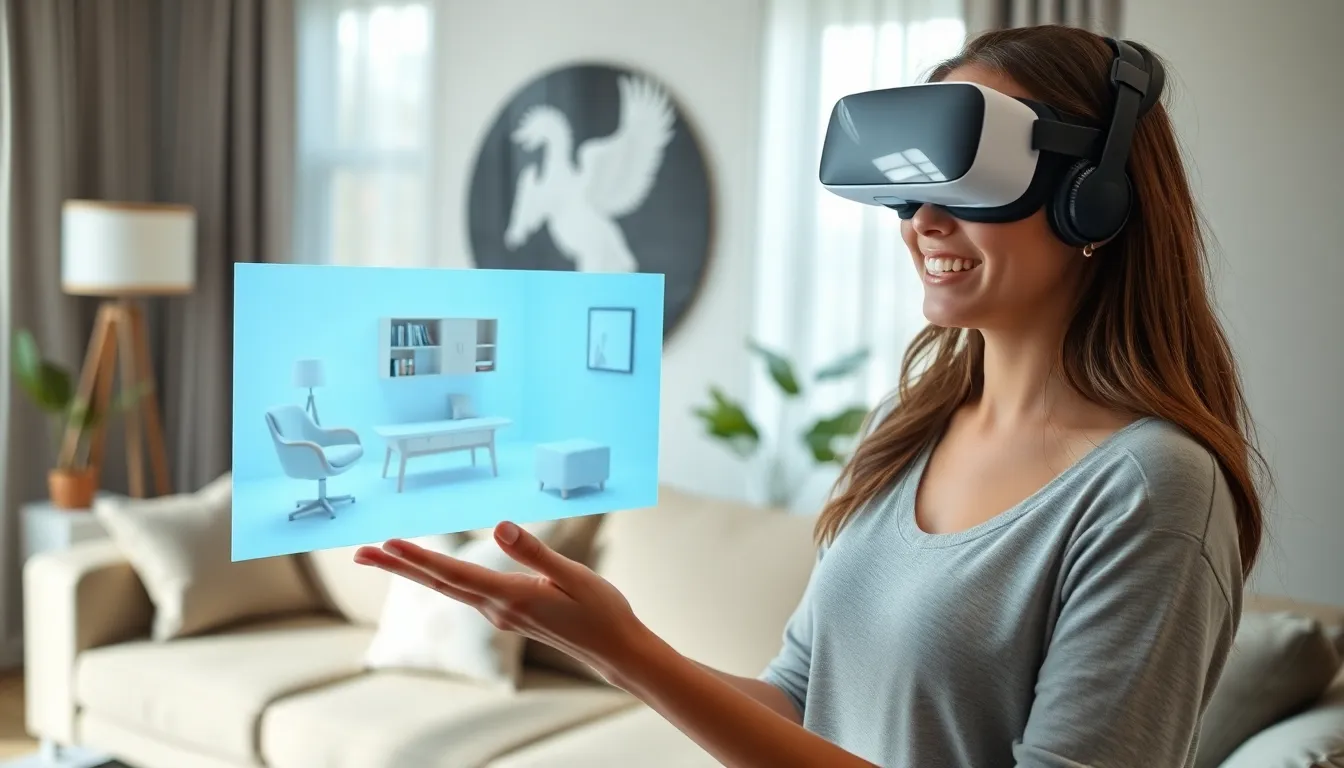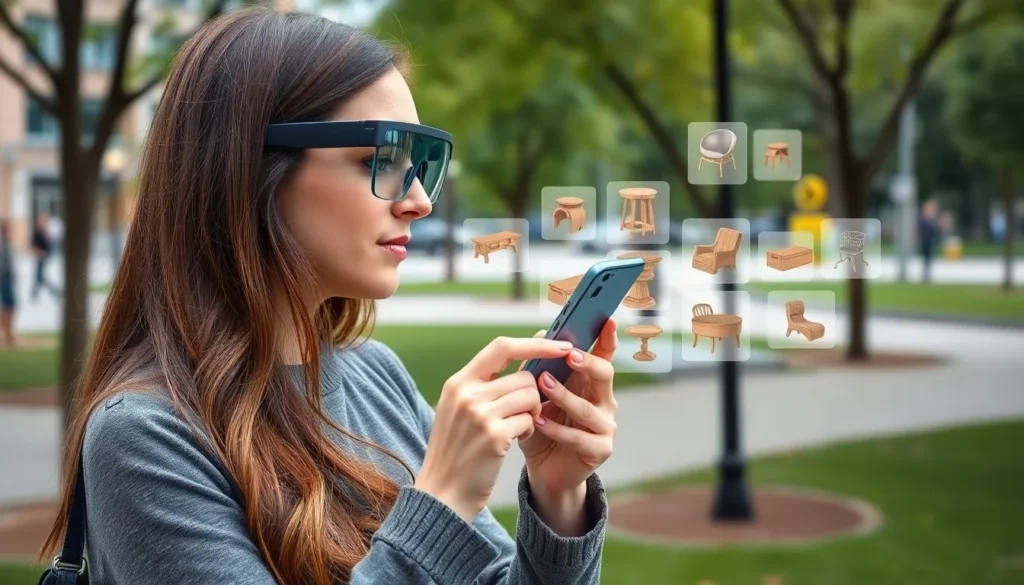Table of Contents
ToggleAugmented reality apps are transforming the way people interact with their surroundings. By blending digital elements with the real world, these innovative applications create immersive experiences that captivate users. From gaming and education to retail and tourism, augmented reality is reshaping industries and enhancing everyday activities.
As technology advances, the potential of augmented reality continues to expand. Users can now visualize products in their homes before making a purchase or engage in interactive learning experiences that bring subjects to life. With countless applications emerging, it’s clear that augmented reality is more than just a trend—it’s a powerful tool that’s here to stay.
Overview of Augmented Reality Apps
Augmented reality apps enhance user experiences by overlaying digital content on the physical environment. These apps utilize devices like smartphones and smart glasses to create engaging interfaces. Users interact with real-world surroundings through immersive visuals and sound.
Key features of AR apps include:
- Geolocation: AR apps often use GPS technology to deliver location-based information. For example, users might view points of interest when exploring a new city.
- Image Recognition: AR apps can interpret images or objects in real-time. Users scan items to unlock contextual information, making learning interactive.
- 3D Modeling: Many AR apps allow users to visualize three-dimensional objects in their space. This feature proves valuable for retailers, enabling customers to see how furniture fits into their homes.
- Social Interaction: Some AR apps incorporate social features, enabling users to share experiences with others. Games often include multiplayer options that enhance collaborative gameplay.
Different sectors benefit from AR apps:
| Sector | Application Example |
|---|---|
| Gaming | Pokémon GO allows exploration while interacting with digital creatures. |
| Education | Google Expeditions provides virtual field trips and immersive learning experiences. |
| Retail | IKEA Place helps customers visualize furniture layouts in their homes. |
| Tourism | AR City offers navigation and historical insights through real-world lenses. |
Continual advancements in AR technology enable developers to enhance user engagement, making these apps a crucial tool in the digital landscape. The potential for innovative applications remains significant as industries explore new ways to integrate augmented reality into everyday life.
Popular Augmented Reality Apps

Numerous augmented reality apps enhance user interactions in various fields. The following subsections detail key applications across gaming, education, and retail.
Gaming Applications
Pokémon GO remains a leading AR gaming application, allowing users to search for and capture virtual creatures in real-world locations. Users engage with their environment, promoting physical activity and exploration. Ingress, another popular app, immerses players in a world where they must capture portals using strategic gameplay. Both apps highlight how AR transforms gaming experiences by blending the digital and physical realms.
Educational Tools
AR educational tools, such as Google Expeditions and Merge Cube, facilitate interactive learning experiences. Google Expeditions provides immersive field trips, allowing students to explore historical sites and complex scientific concepts through AR. Merge Cube lets students hold and interact with three-dimensional objects, enhancing understanding of subjects like anatomy or astronomy. These applications utilize AR’s capabilities to foster engagement and improve retention of information among learners.
Retail and Shopping Experiences
Retail and shopping experiences utilize AR apps like IKEA Place and Sephora Virtual Artist. IKEA Place enables customers to visualize furniture in their homes before purchasing, improving decision-making. Sephora Virtual Artist allows users to try on cosmetics virtually, enhancing the shopping experience while reducing the need for physical samples. Such AR applications empower consumers with visual tools, leading to informed choices in their purchases.
Benefits of Using Augmented Reality Apps
Augmented reality (AR) apps offer various advantages across multiple sectors. They enhance interactions between users and their environments, paving the way for innovative applications.
Enhanced User Experience
Enhanced user experience remains a primary benefit of AR apps. Users benefit from immersive experiences that seamlessly blend digital and physical elements. For instance, in retail, AR apps like IKEA Place allow users to visualize furniture in their homes before purchase, minimizing uncertainty. Similarly, educational tools like Google Expeditions enable students to explore complex subjects through interactive 3D models, fostering deeper comprehension. The ability to visualize and interact with products or concepts enriches the learning and shopping experiences.
Increased Engagement
Increased engagement represents another significant advantage of AR apps. These applications capture user attention through gamification and interactive elements. In gaming, titles like Pokémon GO motivate users to explore their surroundings while completing real-world tasks. This combination of engagement and physical activity leads to a more dynamic experience. Educational AR apps also promote active participation, encouraging students to interact with their learning materials. By transforming passive consumption into active involvement, AR apps drive heightened interest and sustained engagement across various applications.
Challenges and Limitations
Augmented reality (AR) apps face several challenges and limitations that impact their effectiveness and user experience. Below are key areas of concern.
Technical Issues
Technical issues significantly affect the performance of AR apps. Poor connectivity slows down real-time data retrieval, leading to latency in overlay experiences. Device compatibility presents another challenge, as not all smartphones or smart devices support AR functionalities due to hardware limitations. Additionally, challenges with environmental recognition arise, where inconsistent lighting or complex backgrounds can hinder accurate digital overlays, resulting in frustrating experiences for users. Difficulty in battery consumption often limits extended AR usage, as high power requirements may drain devices quickly.
User Adoption
User adoption remains a crucial obstacle for AR apps. Many users lack awareness or understanding of AR technology and its benefits. Limited access to supporting devices hinders potential users from engaging with AR experiences, resulting in a gap in user engagement. Furthermore, user interface complexities can deter individuals unfamiliar with technology, making onboarding challenging. Concerns about privacy and data security also contribute to hesitance, as users worry about how their information might be used. Addressing these concerns is essential for increasing user acceptance and expanding the AR market.
Future Trends in Augmented Reality Apps
Augmented reality (AR) apps are set to evolve significantly, driving new trends that shape user engagement and functionality. Below are key trends expected to influence the future of AR applications:
- Increased Integration with Artificial Intelligence
AR apps will increasingly leverage AI to enhance user personalization. AI algorithms can adapt experiences based on user behavior and preferences, providing tailored interactions that improve engagement.
- Advancements in Wearable Technology
Wearable devices, such as AR glasses, will become more sophisticated. These devices will offer hands-free experiences and seamless integration with everyday activities, enabling users to access information without needing smartphones.
- Expansion into Remote Collaboration
AR will play a pivotal role in remote collaboration tools, allowing teams to interact in virtual environments. This shift will facilitate virtual meetings, training sessions, and collaborative projects, enhancing productivity.
- Enhanced Geolocation Features
AR apps will adopt advanced geolocation capabilities for hyper-localized content. This improvement will provide users with contextually relevant information based on their precise location, enhancing the AR experience in urban spaces.
- Focus on Health and Wellness
AR applications in healthcare will grow, offering interactive training tools and patient care solutions. Surgeons can use AR for surgical simulations, while patients can engage with gamified wellness apps for rehabilitation.
- Integration Within E-commerce Platforms
E-commerce retailers will increasingly incorporate AR for enhanced shopping experiences. Features like virtual try-ons and product visualization will become standard, enabling customers to interact with products in real time before purchase.
- Development of Smart Cities
As cities become smarter, AR apps will contribute to urban planning and public services. Users will receive real-time information about traffic, transportation, and city structures, promoting navigation and exploration.
- Gaming Innovations
The gaming sector will see continued innovation with AR technology, combining physical and digital realms in immersive gameplay. Developers will experiment with new game mechanics, enhancing user interaction and social experiences.
These emerging trends reflect AR’s potential as a transformative technology, promising innovative applications across various industries.
Augmented reality apps are reshaping how users interact with their surroundings. As technology evolves these applications are becoming more sophisticated and accessible. The potential for AR to enhance experiences in gaming education retail and beyond is immense.
Challenges like technical limitations and user adoption remain but addressing these issues will pave the way for broader acceptance. Future advancements promise even more innovative applications making AR an essential part of everyday life. With ongoing developments in AI and wearable technology users can expect increasingly personalized and immersive experiences. As industries continue to explore AR’s capabilities the future looks bright for this transformative technology.



